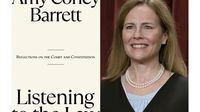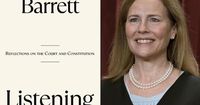Supreme Court Justice Amy Coney Barrett is set to release her highly anticipated book, Listening to the Law: Reflections on the Court and Constitution, on September 9, 2025. The publication is marketed as a unique opportunity for readers to gain insight into the workings of the Supreme Court through Barrett’s own experiences and perspectives.
The announcement from Sentinel Books, a conservative imprint of Penguin Random House, describes Listening to the Law as a window into Barrett’s daily life as a justice. Barrett aims to demystify the process of judging, stating, “The process of judging, which happens behind closed doors, can seem like a mystery. It shouldn’t.” This sentiment reflects her desire to foster a deeper understanding of the judicial role among the general public.
Barrett’s book promises to touch on critical aspects of her work: from her deliberation process to navigating the often tumultuous media landscape. “With the warmth and clarity that made her a popular law professor, she brings to life the making of the Constitution and lays out her approach to interpreting its text,” the announcement reads.
The Supreme Court Justice, now 53 years old, was appointed in 2020, shortly after the death of Justice Ruth Bader Ginsburg, making her the youngest member of the court. As the third justice nominated by former President Donald Trump, Barrett solidified a conservative majority that has since made notable rulings affecting abortion rights, religious liberties, and affirmative action.
Barrett’s contract with Sentinel was first reported back in 2021, and she received a substantial advance of $425,000 as part of a larger $2 million deal. This figure has raised discussions in legal and literary circles about the trend of justices engaging with the public through book deals.
Judicial memoirs from justices are not uncommon, but Barrett’s book appears to inhabit a space between memoir and legal discussion, aiming to appeal to a broader audience. Critics have argued that Barrett’s life experiences might lack the dramatic narrative found in the memoirs of justices like Clarence Thomas and Sonia Sotomayor. The latter two have compelling stories of overcoming adversity, which have provoked interest and empathy. By contrast, Barrett's upbringing and journey to the bench were marked by privilege, raising questions about the depth of her narrative appeal.
Barrett's colleagues have had varied publishing experiences. For example, Justices Neil Gorsuch and Ketanji Brown Jackson have produced works that speak to their judicial philosophies and life stories within shorter timeframes post-appointment. In comparison, Barrett's delayed publication prompts discussions surrounding her productivity on the bench, particularly since she has not authored significant majority opinions since joining the court.
Throughout her tenure, Barrett has taken steps to promote civility and bipartisanship within the court, exemplified by her public engagements with Justice Sotomayor, a member of the court’s liberal wing. The duo has participated in several events together, presenting a unified front amid political polarization at the Supreme Court level. “I don’t think any of us has a ‘my way or the highway’ attitude,” Barrett articulated at a conference for civics educators. This willingness to engage in constructive discourse sets her apart and could resonate with readers looking for a reasoned voice amid partisan divides.
As Barrett’s book release approaches, many are eager to see how she melds personal anecdotes from her experiences with substantial legal principles, particularly originalism—the interpretive approach associated with her judicial philosophy. In inviting readers to “wrestle with questions of originalism,” Barrett opens the door to dialogue about constitutional interpretation in the context of contemporary issues. Many legal observers are curious as to how deeply she will delve into significant Supreme Court cases that have shaped the legal landscape.
However, some industry analysts remain skeptical of whether Barrett's forthcoming work will match the expectations set by her $2 million advance. Critics point out that much of the coverage surrounding Barrett has been marked by contention and scrutiny, especially regarding her stances on pivotal issues that have mobilized both progressive and conservative groups. Her public reception is uncertain as interest from conservative circles might dwindle compared to her initial appointment hype.
Ultimately, Listening to the Law presents an opportunity for Barrett to chart her own narrative path within the ongoing conversation about law and justice. As she weaves her personal and professional life throughout the pages, readers will gain a multifaceted understanding of not only her beliefs but the operational realities of the highest court in the land.
While time will tell if her insights prove compelling enough to draw readers in, one thing is clear: Amy Coney Barrett is prepared to take the public behind the curtain of the Supreme Court like never before.









